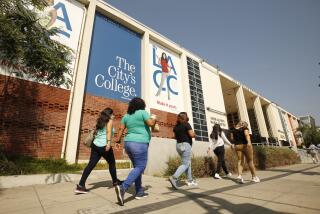Grand Jury Blames Colleges’ Board, Staff for Fiscal Ills
- Share via
The Board of Trustees and top administration of the Los Angeles Community College District are squarely to blame for failing to act sooner to prevent the district’s current financial troubles, the county Grand Jury has concluded after a six-month management audit.
The nine-college system narrowly avoided bankruptcy last year when it asked for and received a $5-million loan from Los Angeles County to cover operating expenses. In the last several months, the district has laid off about 40 faculty members, cut maintainance costs and canceled classes to balance its budget, while searching for ways to restore morale and stem a precipitous enrollment decline.
But the grand jury report, researched and written by the accounting firm of Arthur Young & Co., charges that the district could have ordered belt-tightening measures as early as 1980 when, the report says, the district’s money problems first became known.
“The most damaging fact is that the district didn’t respond to the financial troubles they were in and that they should have recognized” six years ago, said David A. Johnson, who chairs the grand jury’s audit committee.
Community college board President Monroe F. Richman, however, termed the charge “nonsense” and blamed the district’s fiscal problems on the state, which has been the chief source of funds since 1978, when voters passed Proposition 13.
“The real question I would ask is why did the grand jury come along now and do this? . . . There is something politically inspired in this whole thing,” Richman said.
Richman said he would withhold further comment until he has received a copy of the audit statement.
While the 23-member grand jury occasionally is used in criminal cases, its principal function is to serve as a watchdog over county government. Its recommendations are not binding, however.
Among the 40 recommendations contained in the report issued Tuesday, the most urgent ones called for the college trustees and the chancellor to adopt a clear statement of district goals, close Mission College in the northern San Fernando Valley, decentralize authority and make each of the nine campuses fiscally accountable. The grand jury also urged the district to lay off administrators and additional instructors.
According to the study, the major cause of the district’s financial predicament has been its “inability to control expenditures” in response to the decline in enrollment and the resulting decline in state funding, which is based on student attendance. The reason, the report said, was that the district does not maintain separate accounts for each of the nine campuses but lumps the funds, making it difficult to pinpoint where losses occur and revenues are made.
Further, the report identified four colleges that have operated in the red each year since 1980. Harbor, Mission, Southwest and West Los Angeles collectively account for $62.3 million in losses. City College and East Los Angeles College also lost about $9.4 million in the last five years. Only Pierce, Los Angeles Trade-Technical and Valley colleges have consistently generated revenue for the district.
The study urged the district to abandon its plans to build a permanent campus for Mission College, transfer that school’s programs to Valley College and sell the construction site in Sylmar. The report states that the district could save about $12 million in construction costs and administrative salaries.
Although Mission, with 3,300 students, was the only campus in the district to score a slight enrollment gain this spring, district spokesman Norman Schneider confirmed that it has the smallest student body and highest cost per student in the system. However, Schneider said, the district plans to proceed with the permanent campus because the demand for classes from students continues to grow.
The grand jury report recommended that the district make further staff cuts, particularly on the faculty, whose salaries account for 50% of the district budget. The study noted that although the district initiated layoff proceedings against 157 instructors this year, it wound up either rescinding the notices or reassigning most of those teachers to other departments. As of last month, only 48 final dismissal notices had been issued.
“It is unlikely,” the report states, “that fiscal soundness can be restored by countering a 25% enrollment decline by laying off less than 1% of the certificated faculty.”
According to Hal Fox, president of the American Federation of Teachers College Guild, the district has reduced the faculty by 612 positions since 1982 by not filling vacancies created by resignations or retirements. Thus, he said, further layoffs would be counterproductive because they would “destroy programs, as this reduction already is doing. Students can’t get full programs on several campuses now.”
More to Read
Sign up for Essential California
The most important California stories and recommendations in your inbox every morning.
You may occasionally receive promotional content from the Los Angeles Times.











